
A Landing Craft Utility (LCU) is a type of boat used by amphibious forces to transport equipment and troops to the shore. They are capable of transporting tracked or wheeled vehicles and troops from amphibious assault ships to beachheads or piers.

A Landing Craft Utility (LCU) is a type of boat used by amphibious forces to transport equipment and troops to the shore. They are capable of transporting tracked or wheeled vehicles and troops from amphibious assault ships to beachheads or piers.
| Class overview | |
|---|---|
| Name | Golfo de Tribugá class |
| Builders | COTECMAR |
| Operators | |
| Preceded by | LCU-1466-class landing ship utility |
| In service | 2014–present |
| In commission | 2014–present |
| Completed | 8 |
| Active | 8 |
| General characteristics | |
| Type | Landing Craft Utility |
| Displacement | 574.6 t (565.5 long tons) |
| Length | 49.0 m (160.8 ft) |
| Beam | 11.0 m (36.1 ft) |
| Draught | 1.5 m (4 ft 11 in) |
| Propulsion | 2 × Caterpillar C18 diesel motors, 412 kW (553 shp) |
| Speed | 8.5 knots (15.7 km/h; 9.8 mph) |
| Range |
|
| Endurance |
|
| Capacity | 120 t (130 short tons) |
| Troops | 36 |
| Complement | 15 (3 officers) |
The Golfo de Tribugá-class landing craft is an LCU developed by COTECMAR for the Colombian National Navy. The vessel class is also known as BDA (Spanish : Buque de Desembarco Anfibio) and an unarmored version for logistical and humanitarian services has also been developed, known as BALC (Spanish : Buque de Apoyo Logístico y Cabotaje). [1]
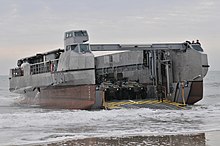
The Engin de débarquement amphibie rapide (EDA-R) landing catamaran or L-CAT, entered service in January 2011. They can carry a main battle tank like other European LCUs but are capable of much higher speeds, up to 30 knots (56 km/h; 35 mph).
 Stör | |
| Class overview | |
|---|---|
| Operators | |
| In service | 1965– |
| Completed | 22 |
| Active | 2 |
| Laid up | 3 |
| General characteristics | |
| Type | Landing craft |
| Displacement | 430 tonnes (420 long tons) (full load) |
| Length | 40 m (131 ft 3 in) |
| Beam | 8.8 m (28 ft 10 in) |
| Draft | 2.1 m (6 ft 11 in) |
| Propulsion | 750 kW (1,010 hp) |
| Speed | 11 knots (20 km/h; 13 mph) |
| Capacity | Up to 150 tonnes (150 long tons) |
| Complement | 17 |
| Armament |
|
Germany has two Barbe-class utility landing craft (Type 520), dating from the mid-1960s, which remain in service under the SEK-M Naval Special Forces' command. Five Barbe landing crafts were transferred to Greece at the end of the Cold War.
 MK.IV LCU (L51) at sea. | |
| Class overview | |
|---|---|
| Name | LCU MK IV class |
| Builders | GRSE |
| Operators | |
| Preceded by | Mk. III LCU |
| Cost | ₹ 2,100 crore (equivalent to ₹43 billionorUS$540 million in 2023) |
| Built | 2011-20 |
| Planned | 8 |
| Completed | 8 |
| Active | 8 |
| General characteristics | |
| Type | Landing craft utility |
| Displacement | |
| Length | 62.8 m (206 ft) [5] |
| Beam | 11 m (36 ft) |
| Draught | 2.2 m (7 ft 3 in) |
| Installed power | 1,840 kW (2,470 hp) each [6] |
| Propulsion | |
| Speed | 15 kn (28 km/h) [5] |
| Range | 1,500 nmi (2,800 km) at 12 kn (22 km/h) [5] |
| Troops | 160 [4] |
| Complement | 56 [6] |
| Sensors and processing systems |
|
| Armament |
|
India currently has 8 Mk IV class LCU. Last MK IV class of LCU was delivered by GRSE in 2020.
 | |
| Class overview | |
|---|---|
| Name | LCU Mk.II (NL) class |
| Operators | |
| Active | 5 |
| General characteristics | |
| Type | Ro-Ro landing craft |
| Displacement | 255 tonnes (251 long tons) |
| Length | 36.3 m (119 ft 1 in) |
| Beam | 6.85 m (22 ft 6 in) |
| Draft |
|
| Capacity | 65 tonnes (64 long tons) |
| Complement | 7 |
| Armament | 2 × Browning .50 calibre (12.7 mm) machine guns |
With the launch of the amphibious transport ship HNLMS Rotterdam in 1998 there was a need for LCUs. The Dutch LCUs are similar to the British LCU Mk.10 with the bridge being set to one side allowing for a roll-on roll-off design. Until 2005 the Netherlands Marine Corps used the LCU Mark I (NL).
In 2005 and 2006 the five vessels were modernized to the type Mark II. The vessels have been stretched by 9 meters to decrease their draft, which increased their load carrying capacity by 20 tons and allows them to come closer to shore. In addition they were fitted with a strengthened bow ramp, and they can now accommodate the Royal Netherlands Army Leopard 2 A6 main battle tank. Because of the lengthening of the Mark II, the Rotterdam can take two LCUs (plus three LCVPs) in its dock. The dock of Rotterdam's sister ship, HNLMS Johan de Witt, has the capacity to transport two LCUs, but carries four LCVPs in davits.
 | |
| Class overview | |
|---|---|
| Name | Dyugon-class landing craft |
| Operators | |
| Completed | 5 |
| Active | 5 |
| General characteristics [8] | |
| Displacement | 280 tonnes (276 long tons) |
| Length | 45 m (148 ft) |
| Beam | 8.6 m (28 ft) |
| Height | 5.1 m (17 ft) |
| Draft | 1.9 m (6.2 ft) |
| Propulsion | Two M507A-2D diesel engines with 9000 hp each |
| Speed | 35 knots (65 km/h; 40 mph) |
| Range | 500 nmi (930 km) |
| Capacity |
|
| Complement | 7 |
| Armament | 2 KPV 14.5 mm machine guns |
The Dyugon-class landing craft are operated by the Russian Navy.
 | |
| Class overview | |
|---|---|
| Name | Swedish: Lätt trossbåt |
| Builders | Djupviks varv |
| Operators | |
| Built | 1995- |
| Active | 16 |
| General characteristics | |
| Type | Fast landing craft |
| Displacement | 65 tonnes (64 long tons) |
| Length | 24.6 m (80 ft 9 in) |
| Beam | 5.4 m (17 ft 9 in) |
| Draft | 1.1 m (3 ft 7 in) |
| Propulsion | 3 x Scania V8 Water jet (3 x 675 hp) |
| Speed | 25 knots |
| Troops | 18 |
| Armament | 1 × 12.7 mm machine gun Mines and depth charges |
Sweden operates 16 small and fast (25 kn) water jet landing craft (Swedish: Lätt trossbåt) with a displacement of 65 tonnes. They are armed with one 12.7 mm machine gun but can also lay out mines and are equipped with depth charges for anti submarine warfare. The vessel type has been exported to the United Arab Emirates.
HSwMS Loke (A344) is a larger vessel with a displacement of 305 tonnes, capable of carrying 150 tonnes. The ship has a crew of 7 and is armed with two 7.62 mm machine guns.
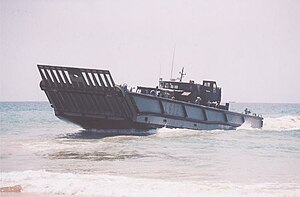 L-602 | |
| Class overview | |
|---|---|
| Name | LCM-1E |
| Builders | Navantia |
| Operators | |
| Preceded by | LCM-8 |
| Planned | 30 |
| Completed | 26 |
| Active | 24 |
| Retired | 2 |
| General characteristics | |
| Type | Roll-on/roll-off landing craft mechanised |
| Displacement |
|
| Length | 23.3 metres (76 ft) |
| Beam | 6.4 metres (21 ft) |
| Draught | 1 metre (3 ft 3 in) loaded |
| Ramps | Bow ramp and stern gate |
| Propulsion |
|
| Speed |
|
| Range | 190 nautical miles (350 km; 220 mi) at economic speed |
| Capacity |
|
| Complement | 4 |
The Armada has 26 LCM-1E in service since 2001 and has been exported to Australia and Turkey.
 LCU Mk.9 (now retired) | |
| Class overview | |
|---|---|
| Name | Landing Craft Utility |
| Operators | |
| Subclasses | LCU Mk.9 and LCU Mk.10 |
| Active | 9 LCU Mk.10s |
| Retired | LCU Mk.9s |
| General characteristics LCU Mk.10 [9] | |
| Displacement | 240 t (240 long tons) |
| Length | 97 ft 10 in (29.82 m) |
| Beam | 25 ft 3 in (7.70 m) |
| Draught | 4 ft 11 in (1.50 m) |
| Propulsion | 2 × MAN D2840 LE diesel engines (400 kW / 2150 r.p.m. each) |
| Speed | 10 knots (19 km/h; 12 mph) |
| Range | 600 nautical miles (1,100 km) |
| Capacity | 1 main battle tank, 4 large vehicles, or 120 troops |
The LCU Mk.9 was built for use on the LPDs Fearless and Intrepid where they were operated from the dock in the rear of the ships. [10] Each ship carried four LCUs and four davit mounted LCVPs. The Mk.9 was to see many changes and upgrades during its service including a move from propeller to jet in many cases. The Mk.9 was capable of traveling as an ocean-going vessel and a number would be converted into a version, affectionately known as the "Black Pig", for use in Norway. The crew had full living quarters aboard with galley and heads. In the Falklands War during the Bluff Cove Air Attacks LCU F4 from Fearless was bombed and sunk in Choiseul Sound by an Argentine Air Force A-4B Skyhawk of Grupo 5. [11] The Mk.9, like the LPDs, served longer than ever anticipated, providing the backbone of Britain's amphibious assault capabilities.
Three Mk.9s, pennant numbers 701, 705, and 709, remained in service by 2012. [10] [12] However, by 2014, they had all been withdrawn from service. [13]
The LCU Mk.10 class vessels are operated by the Royal Marines. They are intended for use on board the assault ships Albion and Bulwark and can also be used by the Bay class landing ships. Deliveries of the class started from 1998 and the fleet currently consists of nine vessels. Both Albion and Bulwark are capable of carrying four LCUs each. These vessels are capable of operating independently for up to 14 days with a range of 600 nautical miles. They are capable of operating worldwide, from Arctic operating areas to tropical operating areas. The Mk.10 differs greatly from the Mk.9 with the bridge being set to the side allowing for a roll-on roll-off design. This greatly increases efficiency over the old Mk.9 as loading of the rear LCUs can take place without the LCUs being launched, the LPD having to dock down to do so, to change over and load up, which was a problem prior to the Falklands landings. The LCU Mk.10 has a 7-man crew and can carry up to 120 Marines or alternatively 1 battle tank or 4 lorries. British assault ships also carry smaller LCVPs on davits to transport troops and light vehicles.
Ten Mk.10s, pennant numbers 1001 to 1010, were in service as of 2012. [12] In 2023 it was reported that 9 of the craft remained in service. [14]
The United States Navy built 1,394 Landing Craft Tank (LCT) in World War II. Those that were still in use in 1949 were redesignated as Landing Craft Utility (LCU).
Seventy old LCUs (likely ex-LCTs) were retired from amphibious duties and reclassified as Harbor utility craft (YFU).
 LCU-1627 | |
| Class overview | |
|---|---|
| Name | LCU 1466, 1610 and 1627 classes |
| Operators | |
| Active | 32 [15] |
| General characteristics | |
| Displacement | see table |
| Length | see table |
| Beam | see table |
| Draft | see table |
| Propulsion | see table |
| Speed | see table |
| Range | see table |
| Endurance | 10 days [15] |
| Capacity | see table |
| Troops | see table |
| Sensors and processing systems | LN 66 or SPS-53 I band navigation radar |
| Armament | 2 × Browning .50 caliber machine guns |
The LCU 1466, 1610 and 1627 class vessels are operated by the United States Navy at support commands. [16] [17] They are a self-sustaining craft complete with living accommodations and mess facilities for a crew of thirteen. [15] Each LCU is assigned a non-commissioned-officer-in-charge (Craft Master) who is either a chief petty officer or petty officer first class in the boatswain's mate, quartermaster or operations specialist rating. These vessels have bow ramps for onload/offload and can be linked bow to stern gate to create a temporary pier-like structure. Its welded steel hull provides high durability with deck loads of 3,900 kg/m2 (800 pounds per square foot). Arrangement of machinery and equipment has taken into account built-in redundancy in the event of battle damage.
The craft features two engine rooms separated by a watertight bulkhead to permit limited operation in the event that one engine room is disabled. An anchor system is installed on the starboard side aft to assist in retracting from the beach. These vessels are normally transported to their areas of operation onboard larger amphibious vessels such as LSDs, LHDs and LHAs.
Introduction of the larger LCU-1610 class resulted in the US Navy constructing the Anchorage class of Landing Ships, Dock (LSD). [18]
LCU-1618 was converted to support the testing of Remotely operated underwater vehicles and Autonomous underwater vehicles and was given the name USS Orca (IX-508). [19]
The 40-year-old craft will be replaced under LCU 1700 [20] (ex-Surface Connector (X) Recapitalization, or SC(X)R), project starting in 2017. [15]
| [16] [17] [21] | LCU 1466 | LCU 1610 | LCU 1627 |
|---|---|---|---|
| Displacement – light | 180 long tons (183 t) | 172 long tons (175 t) | 200 long tons (203 t) |
| Displacement – full | n/a | 353 long tons (359 t) | 386 long tons (392 t) |
| Length overall | 115 ft 1 in (35.08 m) | 134 ft 9 in (41.07 m) | 134 ft 9 in (41.07 m) |
| Beam | 34 ft 0 in (10.36 m) | 29 ft 10 in (9.09 m) | 29 ft 10 in (9.09 m) |
| Draft – full load, forward | 6 ft 0 in (1.83 m) | 4 ft 10 in (1.47 m) | 6 ft 9 in (2.06 m) |
| Draft – full load, aft | 2 ft 9 in (0.84 m) | 3 ft 6 in (1.07 m) | 3 ft 6 in (1.07 m) |
| Power – sustained | 675 hp (503 kW) | 1,000 hp (746 kW) | 680 hp (507 kW) |
| Propulsion | 3 x Gray Marine diesel engines | 2 x Detroit 12V-71 diesel engines | 4 x Detroit diesel engines |
| Shafts | 3 | 2 | 2 |
| Speed | 8 knots (15 km/h; 9.2 mph) | 11 knots (20 km/h; 13 mph) | 8 knots (15 km/h; 9.2 mph) |
| Range | 1,200 nmi (2,200 km) at 6 kn (11 km/h) | 1,200 nmi (2,200 km) at 8 kn (15 km/h) | 1,200 nmi (2,200 km) at 6 kn (11 km/h) |
| Complement | 14 | 14 | 12–14 |
| Capacity – troops | 300 | 400 | 350 |
| Capacity – cargo | 167 long tons (170 t) | 180 long tons (183 t) | 125 long tons (127 t) |
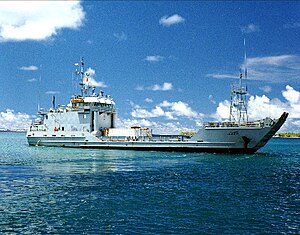 | |
| Class overview | |
|---|---|
| Name | Runnymede-class large landing craft |
| Operators | |
| General characteristics | |
| Displacement |
|
| Length | 174 ft (53 m) |
| Beam | 42 ft (13 m) |
| Draft |
|
| Speed | 11.5 knots (21.3 km/h; 13.2 mph) |
| Range | |
| Capacity |
|
| Complement | 13 |
The Runnymede-class large landing craft or LCU 2000 class vessels are operated by the United States Army. [22] [23] They transport rolling and tracked vehicles, containers, and outsized and general cargo from ships offshore to shore, as well as to areas that cannot be reached by oceangoing vessels (coastal, harbor, and intercoastal waterways). They can be self-deployed or transported aboard a float-on/float-off vessel. They are classed for full ocean service and one-man engine room operations and built to U.S. Coast Guard standards. The vessel can sustain a crew of 2 warrant officers and 11 enlisted personnel for up to 18 days and 10,000 miles. This class is also equipped with an aft anchor to assist in retracting from the beach.

The LCU 1700-class boats are destined to replace the existing LCU 1610-class of amphibious landing craft on a one-to-one basis. The LCU-1700 is 139 feet long, can reach speeds of 11 knots, has a range of 1,200 nautical miles at 8 knots, and has accommodations for a mixed gender crew of 14. It can carry two M1A1 tanks, or 350 combat troops, or 170 short tons of cargo. [24]
The contract announcement noted that the LCU 1700s will recapitalize the LCU fleet as a similarly rugged steel craft (to the LCU 1610) with a design life of 30 years. [25] The similarities of these two classes of ships will help the U.S. Navy to improve efficiency and reduce cost of the training programs, operations and overall ownership cost. The craft will enter, exit and be transported in well decks of current and programmed U.S. Navy amphibious warfare ships, for design purposes defined by the dimensions of LHD, LPD, LSD and LHA classes without ship alterations, while transporting loads up to 11 feet high above the craft’s vehicle deck. [26] The contract was awarded to Swiftships in 2018 to design and build the prototype and up to 32 vessels. Work is being performed in Morgan City, Louisiana, and was expected to be completed by November 2023. [27] [28]
As of February 23, 2024, the U.S. Navy has ordered the builder to stop work and moved to terminate the contract due to challenges and disagreements on the program. [29]

The San Antonio class is a class of amphibious transport docks, also called a "landing platform, dock" (LPD), used by the United States Navy. These warships replace the Austin-class LPDs, as well as the Newport-class tank landing ships, the Anchorage-class dock landing ships, and the Charleston-class amphibious cargo ships that have already been retired.
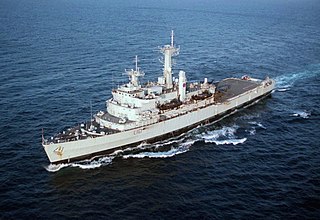
HMS Fearless (L10) was a Royal Navy amphibious assault ship that served from 1965 until 2002. One of two Fearless-class landing platform docks, she was based in HMNB Portsmouth and saw service around the world over her 37-year life. She was the last steam-powered surface ship in the Royal Navy.

The Galicia class are two landing platform dock (LPD) ships in service with the Spanish Navy. Built by Navantia at Ferrol, their mission is to carry out amphibious warfare by transporting the bulk of the Infantería de Marina. These ships have both a large helicopter flight deck and a 885-square-metre (9,530 sq ft) well deck for large landing craft, as well as a 1,000-square-metre (11,000 sq ft) space for up to 33 main battle tanks.

Newport-class tank landing ships were an improved class of tank landing ship (LST) designed for and employed by the United States Navy from 1969 to 2002. The ships were intended to provide substantial advantages over their World War II-era predecessors. Larger and faster than any previous LST design, they carried a ramp over the bow that allowed them to surpass 20 knots, a goal of the United States amphibious forces. 27 were planned of which twenty were completed, the high number due to the demands of US force projection estimates. However, the arrival of the air-cushioned landing craft which allowed for over-the-horizon attacks made the class obsolete in the eyes of the United States Navy. Placed in reserve, twelve were eventually sold to foreign navies, while the remaining eight have since been decommissioned.
A joint support ship (JSS) is a multi-role naval vessel capable of launching and supporting joint amphibious and airlift operations. It can also provide command and control, sealift and seabasing, underway replenishment, disaster relief and logistics capabilities for combined land and sea operations.

USS Sumter (LST-1181) was the third of twenty Newport-class tank landing ships in service with the United States Navy, which replaced the traditional bow door-design tank landing ships (LSTs). Sumter was constructed by Philadelphia Naval Shipyard in Philadelphia, Pennsylvania and was launched in 1969. The ship entered service in 1970, was assigned to the Pacific coast of the United States and deployed to the western Pacific twice during the Vietnam War. In 1973, Sumter was reassigned to the Atlantic coast and took part in operations in along the Eastern Seaboard of the United States, the Mediterranean Sea and the Caribbean Sea. The LST was decommissioned in 1993.

Galicia (L51) is a Galicia-class landing platform dock (LPD) of the Spanish Navy and is the seventh ship to bear this name. She is the lead ship in her class. The vessel was constructed in Ferrol, Spain and launched in 1997 and commissioned in 1998. Galicia is tasked with transporting Spanish marines, humanitarian aid missions and general logistic support. The LPD has taken part in actions against piracy in the Indian Ocean and off the Somalian coast, provided humanitarian aid following hurricanes and tsunamis and provided support during the COVID-19 pandemic in Spain.

USS La Moure County (LST-1194) was the sixteenth of twenty Newport-class tank landing ship of the United States Navy (USN) which replaced the traditional bow door-design tank landing ships (LSTs). The second vessel named after a county in North Dakota, the LST was constructed by National Steel and Shipbuilding Company of San Diego, California. The vessel was launched and was commissioned into the USN in 1971. La Moure County alternated deployments in the Caribbean Sea with those to the Mediterranean Sea. During the Gulf War, La Moure County transported elements of the 4th Marine Expeditionary Brigade to the Persian Gulf. In 2000, the LST was taking part in a training exercise off Chile when the vessel ran aground. Considered beyond repair, La Moure County was decommissioned that year and towed out to sea in 2001 and sunk as a target ship.

USS San Bernardino (LST-1189) was the eleventh of twenty Newport-class tank landing ships of the United States Navy (USN) which replaced the traditional bow door-design tank landing ships (LSTs). The second USN ship to be named after the city in California, the ship was constructed by National Steel and Shipbuilding Company of San Diego, California. The LST was launched in 1970 and was commissioned in 1971. San Bernardino participated in the Vietnam War, earning one battle star and took part in operations in the Middle East. The ship was decommissioned 1995 and transferred to the Chilean Navy. In Chilean service, the vessel was renamed Valdivia (LST-93) for a battle during the Chilean War of Independence. The LST was recommissioned that year and during its service, took part in humanitarian efforts following earthquakes in Chile in 2010. In 2011 the Chilean Navy took Valdivia out of service due to repairs to the ship no longer being economical.

USS Manitowoc (LST-1180) was the second ship of the Newport-class tank landing ships which replaced the traditional bow door-design tank landing ships (LSTs) in service with the United States Navy. Manitowoc was constructed by the Philadelphia Naval Shipyard in Philadelphia, Pennsylvania and launched in 1969 and entered service in 1970.

USS Fresno (LST-1182) was the fourth tank landing ship (LST) of the Newport class. Fresno was named for a county in California. The vessel was constructed by the National Steel and Shipbuilding Company in San Diego, California and launched in 1968. The ship entered service in 1969 and was assigned to the United States Pacific Fleet, taking part in training along the west coast and operational cruises to the western Pacific, taking part in the Vietnam War. Fresno was decommissioned in 1993 and laid up. The LST was nearly sold to Peru but remained in the U.S. inventory until 2014, when Fresno was sunk as a target ship in the Pacific Ocean during a training exercise off Guam.

An amphibious assault ship is a type of amphibious warfare ship employed to land and support ground forces on enemy territory during an amphibious assault. The design evolved from aircraft carriers converted for use as helicopter carriers. Modern designs support amphibious landing craft, with most designs including a well deck. Like the aircraft carriers they were developed from, some amphibious assault ships also support V/STOL fixed-wing aircraft and have a secondary role as aircraft carriers.

USS Bristol County (LST-1198) was the last of the twenty Newport-class tank landing ships of the United States Navy (USN) which replaced the traditional bow door-design tank landing ships (LSTs). The LST was constructed by National Steel and Shipbuilding Company of San Diego, California. Bristol County was launched in 1971 and commissioned into the USN in 1972. Bristol County was assigned to the United States Pacific Fleet and remained in service until 1994 when it was decommissioned. Sold to Morocco that year, the vessel was recommissioned into the Royal Moroccan Navy as Sidi Mohammed Ben Abdellah. The ship remains in service.

Castilla (L52) is a Galicia-class landing platform dock (LPD), and is the twelfth ship of this name. She is the sister ship to the amphibious warfare vessel Galicia. The vessel is primarily used to transport Spanish marines but is also used for humanitarian aid missions. Launched in 1999 and commissioned in 2000, Castilla took part in Operation Romeo Sierra as part of the Perejil Island crisis in 2002, has participated in multiple military exercises with NATO and provided humanitarian relief in the Caribbean Sea and Gulf of Mexico.

An amphibious warfare ship is an amphibious vehicle warship employed to land and support ground forces, such as marines, on enemy territory during an amphibious assault.

The Landing Craft Vehicle Personnel (LCVP) is a versatile amphibious landing craft designed to transport troops or armoured vehicles from ship to shore during amphibious landings. The designation was first used in British service for the LCVP Mk2s introduced with the two Fearless class amphibious transport docks, the role having previously been carried out by the Landing Craft Assault developed during the Second World War. They are manned and operated by 1 Assault Group Royal Marines.
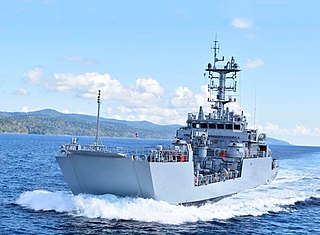
Mk IV LCU class vessels follow on class of Mk. III LCU operated by the Indian Navy. The Mk IV LCU can be deployed for maritime roles that require amphibious capabilities.

Mk III LCU class vessels were follow on class of Mk II LCU operated by the Indian Navy and were meant to augment the Indian Navy's amphibious capability. The ships were deployed for maritime roles like maritime security, beaching, un-beaching, humanitarian relief operations and evacuation from distant islands, search and rescue operations and peace-keeping missions. The landing craft were meant for use by amphibious forces to transport equipment and troops to the shore. They were capable of transporting tracked or wheeled vehicles and troops from amphibious assault ships to beachheads or piers. The landing craft were carried on board amphibious assault ships to the objective area. Built and delivered between 1986-87 the mission of the LCU was to land/retrieve personnel and equipment during amphibious operations. LCU's help land personnel and equipment after the initial assault waves of an amphibious operation.